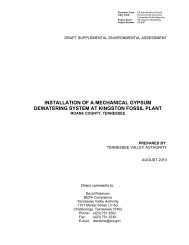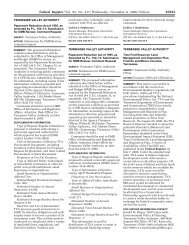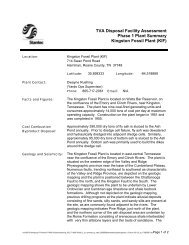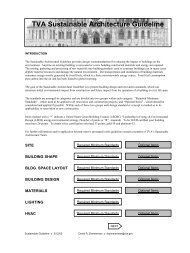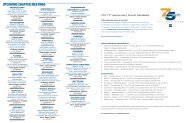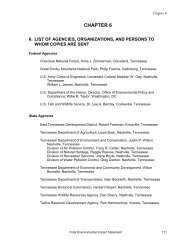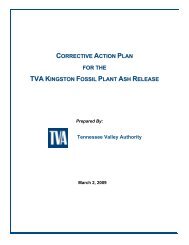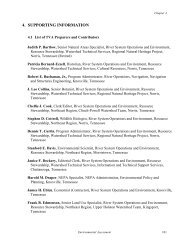Environmental Assessment - Tennessee Valley Authority
Environmental Assessment - Tennessee Valley Authority
Environmental Assessment - Tennessee Valley Authority
Create successful ePaper yourself
Turn your PDF publications into a flip-book with our unique Google optimized e-Paper software.
measures associated with the Action Alternative, impacts to aquatic organisms and water<br />
quality from disturbance or modification of adjacent land and the riverbed would be<br />
minimized.<br />
Water Withdrawal<br />
For LUB to meet increasing water demands, the treatment plant and intake structure will<br />
need to be expanded from the current capacity of 14 to 20 MGD. While the existing raw<br />
water intake has sufficient capacity to supply 22 MGD to the plant, the intake does not<br />
provide adequate firm pumping capacity for the expanded plant capacity of 20 MGD.<br />
Jordan, Jones & Goulding, engineering consultants for LUB (see Attachment A), provided<br />
historic and projected water demand from 2005 to 2020. This demand was categorized as<br />
minimum day, average day, and peak day demand. Analyses of the 2009 demand<br />
projections indicated that average day demand would be approximately 80 percent of<br />
capacity and would likely exceed plant capacity by 2015. Analyses also indicated that peak<br />
day demand would likely exceed plant capacity during 2010.<br />
No Action Alternative - If TVA adopts the No Action Alternative, the volume of water<br />
withdrawn from the <strong>Tennessee</strong> River by LUB would not be increased. There would be no<br />
effect on water withdrawal. If the existing treatment plant and intake structure capacities<br />
are not expanded, water demand would exceed capacity over the next few years, and LUB<br />
would not be able to meet customer demand.<br />
Action Alternative With Modification - The Action Alternative is to construct a new raw water<br />
intake structure and piping to support expansion of the WTP. This new intake structure<br />
would increase Loudon Utilities’ pumping capacity from 14 MGD to 20 MGD. An analysis of<br />
increased water withdrawal was conducted to determine the following:<br />
• Whether the withdrawal increase would adversely impact downstream<br />
municipal/industrial water supplies<br />
• Whether the water intake structure was at a sufficient depth to prevent operational<br />
impacts during low flows<br />
• Whether the water withdrawal increase aligned with forecasted customer water<br />
demand in the future<br />
Two industrial water intake facilities are immediately downstream of LUB’s proposed water<br />
intake structure. Viskase Corporation (TRM 591.7) withdraws approximately 1.5 MGD,<br />
while Kimberly Clark Corporation (TRM 589.9) withdraws approximately 5.0 MGD.<br />
Because of flows in the river at these locations (approximately 9,000 MGD average flow<br />
and 1,265 MGD on lowest-flow day of 2007, which was the driest year of record),<br />
increasing Loudon Utilities’ withdrawal from 14 MGD to 20 MGD represents only 0.07<br />
percent of the average flow, or 0.5 percent of the 2007 low-flow day. This degree of<br />
increase in withdrawals should have no adverse effect on downstream municipal/industrial<br />
water withdrawals by others.<br />
The proposed water intake structure would have a top-of-screen elevation of no higher than<br />
721 feet msl. Maximum drawdown elevation for Watts Bar Reservoir is 733 feet msl,<br />
leaving at least 12 feet of water over the top of the intake structure. This would likely<br />
ensure continuous operation during normal low water elevations in the reservoir.<br />
14





